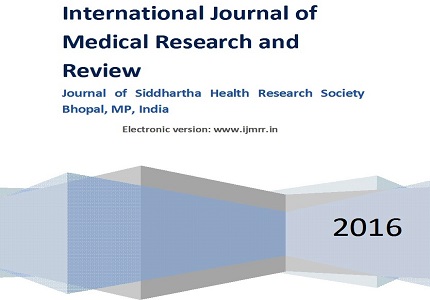Utility of uterine artery Doppler and pulsatility index at 11-14 weeks of normal pregnancy in prediction of preeclampsia in third trimester
Abstract
Introduction: Preeclampsia affects 5-8% of women in pregnancy and leading cause of maternal mortality. The present study was done to predict the development of preeclampsia in patients with uterine artery pulsatility index (PI) >1.71 and the presence of diastolic notch at 11-14 weeks of gestation belonging to low risk population.
Methods: Women attending routine antenatal care were offered an early transvaginal ultrasound scan between 11-14 weeks including uterine artery doppler assessment. Mean PI and presence or absence of bilateral early diastolic notch was also noted. All patients were followed up to term for the development of preeclampsia.
Results: Out of 100 patients, 22% developed preeclampsia of which 15 (68.18%) cases showed the presence of diastolic notch and 12 (54.54%) cases had PI >1.71 (p<0.05). A Total of 12% of patients showed presence of both diastolic notch and PI of >1.71 (p<0.05). Out of 37 nulliparous patients 13 (35.13%) developed preeclampsia, 8 (13.79%) out of 58 primiparous and 1 (20%) out of 5 multipara developed preeclampsia (p<0.05). All 11 patients with systolic blood pressure >140mm of Hg at 11-14 weeks of gestation developed preeclampsia (p<0.05).
Conclusion: Presence of diastolic notch and PI of >1.71 in uterine artery colour doppler at 11-14 weeks of gestation serves as a good predictor of preeclampsia at term, in pregnancies with no other associated risk factors.
Downloads
References
2. Harrington K, Cooper D, Lees C, Hecher K, Campbell S. Doppler ultrasound of the uterine arteries: the importance of bilateral notching in the prediction of pre-eclampsia, placental abruption or delivery of a small-for-gestational-age baby. Ultrasound Obstet Gynecol. 1996 Mar;7(3):182-8. [PubMed]
3. Vainio M, Kujansuu E, Iso-Mustajärvi M, Mäenpää J. Low dose acetylsalicylic acid in prevention of pregnancy-induced hypertension and intrauterine growth retardation in women with bilateral uterine artery notches. International Journal of Obstetrics and Gynaecology 2002; 109(2):161-7.
4. Desai P. Predicting Obstetric Vasculopathies through Study Diastolic notch and Other Indices of Resistance to Blood Flow in Uterine Artery. Int J Infertility Fetal Med 2013; 4 (1):24-30.
5. Rattanapuntamanee O, Uerpairojkit B. Reference range and characteristic of uterine artery Doppler in pregnant Thai women at 11-13(+6) gestational weeks. J Med Assoc Thai. 2011 Jun;94(6):644-8. [PubMed]
6. Martinez RC, Savchev S, Lemini MC, Mendez A, Gratacos E, Figueras F. Clinical utility of third-trimester uterine artery Doppler in the prediction of brain hemodynamic deteriorationand adverse perinatal outcome in small-for-gestational-age Fetuses. Ultrasound Obstet Gynecol 2015; 45 (3): 273–8.
7. Gómez O, Martínez JM, Figueras F, Del Río M, Borobio V, Puerto B et al. Uterine artery Doppler at 11-14 weeks of gestation to screen for hypertensive disorders and associated complications in an unselected population. Ultrasound Obstet Gynecol 2005; 26(5):490-4.
8. Gupta S, Kumar GP, Preeti B, Anshu K. Transvaginal Doppler of uteroplacental circulation in early prediction of pre-eclampsia by observing bilateral uterine artery notch and resistance index at 12-16 weeks of gestation. J Obstet Gynecol India 2009; 59 (6):541-6. [PubMed]
9. Kiondo P, Wamuyu-Maina G, Bimenya GS, Tumwesigye NM, Wandabwa J, Okong P. Risk factors for pre-eclampsia in Mulago Hospital, Kampala, Uganda. Trop Med Int Health. 2012 Apr;17(4):480-7. doi: 10.1111/j.1365-3156.2011.02926.x. Epub 2011 Dec 13. [PubMed]
10. Dinglas C, Lardner D, Homchaudhur A , Kelly C, Briggs C, Passafaro M. Relationship of Reported Clinical Features of Pre-eclampsia and Postpartum Haemorrhage to Demographic and other Variables. West African Journal of Medicine. 2011; 30(2): 84–8.
11. Mangal A, Kumar V, Panesar S, Talwar R, Raut D, Singh S. Updated BG Prasad socioeconomic classification, 2014: a commentary. Indian J Public Health. 2015 Jan-Mar;59(1):42-4. doi: 10.4103/0019-557X.152859. [PubMed]
12. Silva LM, Coolman M, Steegers EA, Jaddoe VW, Moll HA, Hofman A, Mackenbach JP, Raat H. Low socioeconomic status is a risk factor for preeclampsia: the Generation R Study. J Hypertens. 2008 Jun;26(6):1200-8. doi: 10.1097/HJH.0b013e3282fcc36e.
13. Long PA, Abell DA, Beischer NA. Parity and pre-eclampsia. Aust N Z J Obstet Gynaecol. 1979 Nov;19(4):203-6. [PubMed]
14. Myatt L, Clifton RG, Roberts JM, Spong CY, Hauth JC, Varner MW, Wapner RJ, Thorp JM Jr, Mercer BM, Grobman WA, Ramin SM, Carpenter MW, Samuels P,Sciscione A, Harper M, Tolosa JE, Saade G, Sorokin Y, Anderson GD; Eunice Kennedy Shriver National Institute of Child Health and Human Development (NICHD) Maternal-Fetal Medicine Units Network (MFMU). The utility of uterine artery Doppler velocimetry in prediction of preeclampsia in a low-risk population. Obstet Gynecol. 2012 Oct;120(4):815-22.
15. Pilalis A, Souka AP, Antsaklis P, Daskalakis G, Papantoniou N, Mesogitis S, Antsaklis A. Screening for pre-eclampsia and fetal growth restriction by uterine artery Doppler and PAPP-A at 11-14 weeks' gestation. Ultrasound Obstet Gynecol. 2007 Feb;29(2):135-40.



 OAI - Open Archives Initiative
OAI - Open Archives Initiative


